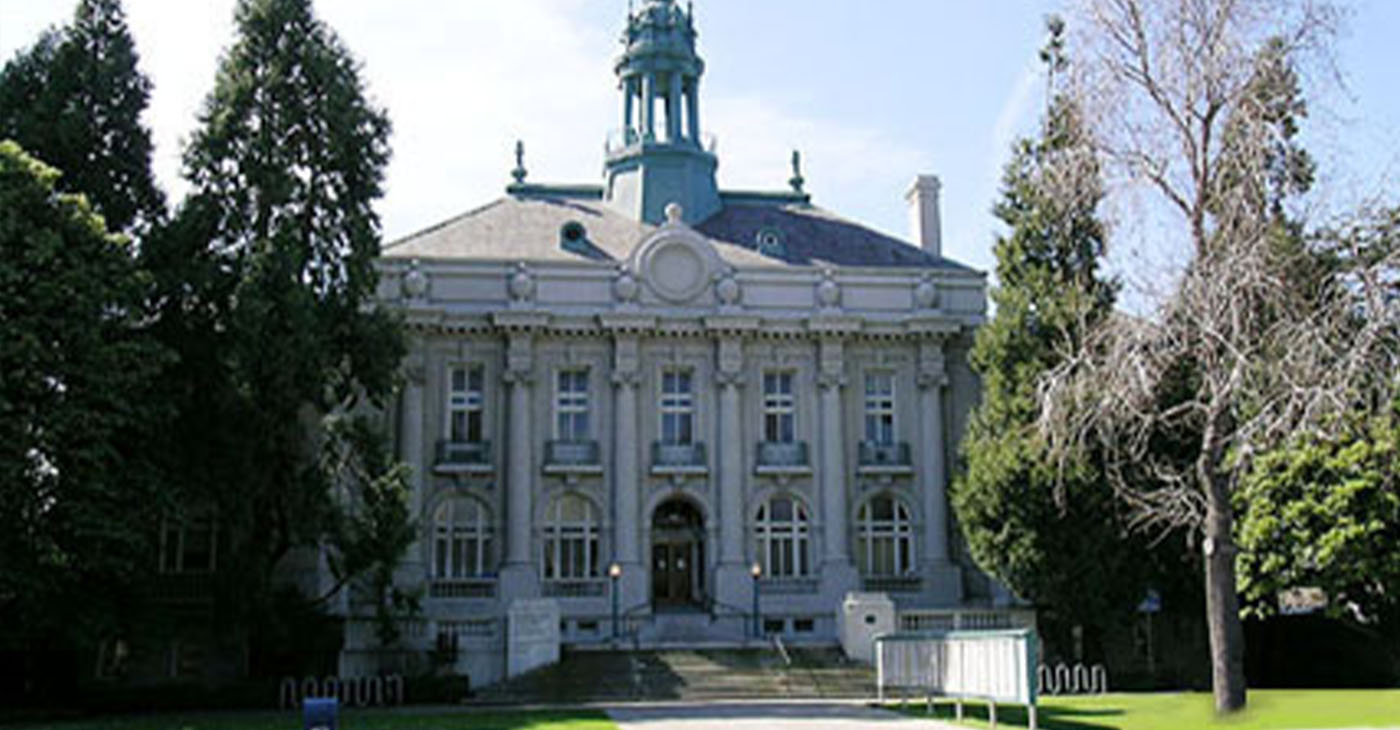Berkeley
New Paper: State’s Cap-and-Trade Program is Falling Short of Goals

California regulators are overestimating the impact the state’s cap-and-trade system is having on reducing greenhouse gas emissions, according to a new policy brief from a researcher at UC Berkeley’s Center for Environmental Public Policy, part of the Goldman School of Public Policy.
In the paper, published Tuesday, research fellow Barbara Haya argues that the California Air Resources Board has made rosy assumptions about a program protecting forests that may only have accomplished 18% of the emission reductions it claims have been made.
The discrepancy could be as much as 80 million tons of carbon dioxide since 2013, which is equivalent to more than the total annual emissions from California’s entire electricity sector.
The issue is significant because California is designing its cap-and-trade and carbon offset programs to be a model for other jurisdictions, said Haya, who has spent the last eight years analyzing California’s program.
“But this program does much less than we say it does,” Haya says. “The worry is that we’re exporting policy that doesn’t do what we think it is doing.”
“We have to do this right if we want to hit our target of reducing greenhouse gas emissions 40% below 1990 levels by 2030,” Haya added, pointing to a state goal passed by the state Legislature in 2016. “We are setting a standard that a lot of people are looking at.”
At issue is California’s U.S. Forest Projects offset protocol, an incentive program designed by the state to encourage forestland owners across the country to manage forests in ways that increase the amount of carbon stored in them.
These arboreal stores of carbon create credits that California’s industrial polluters, like power plants, can then buy to offset their own emissions.
‘We don’t stop building homes’
But the economy still requires lumber for housing or furniture and wood pulp for paper. And that’s where California’s system runs into trouble, Haya said.
Even when forestland owners change their logging practices, the demand for lumber or paper doesn’t decrease, it shifts to other forests.
“We don’t stop building homes or making wood furniture,” she said. “Those trees have to be cut down somewhere.”
California assumes that 20% of timber harvesting reduced by California’s forest offset protocol is done in forests that are not part of the cap-and-trade system to meet timber demand, and the state accounts for that when it issues carbon credits.
But that 20% figure, called a leakage rate, is not supported by academic literature, Haya found. It’s more accurate to say that, in California’s program, 80% of the reduction is shifted to other forests.
In other words, Haya said, California regulators are underestimating how many carbon-storing trees are actually being protected by the cap-and-trade program. As a result, greenhouse gas emissions are not falling as quickly as they should.
A question of timing
Another problem Haya’s analysis found was a question of when the effects of this leakage rate, whether it is 20% as the state claims or 80% as Haya argues, are accounted for.
Under the current policy, timber companies and other landowners get immediate credit in the cap-and-trade market for deciding to preserve their forests. But the deduction for all the trees still cut down because of demand for wood products — leakage — is applied over the next 100 years.
This system of early reward, Haya said, creates a cap-and-trade market flush with carbon credits that polluters can buy to avoid reducing their own emissions in the short term.
“It’s like getting a 100-year loan for emissions,” Haya said, drawing an analogy. “You get all the credits now but some portion of those credits are for deductions that need to be made over 100 years. We don’t have 100 years.”
The system should instead focus on the net reduction in emissions that is actually created each year, she said.
“We’re starting at deficit where we’re giving a lot of credits to the landowners,” Haya said. “The way the protocol should work is that, in the same year that landowners are being credited for not harvesting, they should be credited for their net effect on emissions.”
Still many positives
While the cap-and-trade program must be fixed, Haya said California emissions regulators are still doing an excellent job reducing the overall amount of greenhouse gas emissions being released in the state.
“We’re doing a lot of really good things to reduce our emissions, including our renewables portfolio standard, our efficiency standards and our support for electric vehicles,” Haya said. “We are a leader in climate change policy in the U.S. and the world, and we’re doing an incredible amount of really good work.”
That’s why structuring the state’s cap-and-trade program to actually reduce emissions is so important, she said.
“We are creating the cap-and-trade program as a model for the world,” she Haya said. “It’s really important that we get this right.”
Activism
Who are the Alameda County District 4 Supervisor Candidates’ Top Campaign Contributors?
Below, we’ve listed each candidate’s 10 highest campaign contributors. For Miley, two of his top campaign donors also bought their own advertisements to support him and/or oppose Esteen through independent expenditures. Such expenditures, though separate from campaign donations, are also public record, and we listed them. Additionally, the National Organization of Realtors has spent about $70,500 on their own independent expenditures to support Miley.

By Zack Haber
Nate Miley, who has served on Alameda County’s Board of Supervisors since 2000, is running for reelection to the District 4 supervisor seat.
Jennifer Esteen, a nurse and activist, is seeking to unseat him and become one of the five members of the powerful board that sets the county’s budget, governs its unincorporated areas, and oversees the sheriff, Alameda Health System, and mental health system.
District 4 includes most of East Oakland’s hills and flatlands beyond Fruitvale, part of Pleasanton and unincorporated areas south of San Leandro like Ashland and Castro Valley.
Voting is open and will remain open until March 5.
In California, campaign donations of $100 or more are public record. The records show that Miley has received about $550,000 in total campaign donations since he won the previous District 4 election in March 2020. Esteen has raised about $255,000 in total campaign donations since she started collecting them last July. All figures are accurate through Feb. 20.
While Miley has raised more money, Esteen has received donations from more sources. Miley received donations of $100 or more from 439 different sources. Esteen received such donations from 507 different sources.
Below, we’ve listed each candidate’s 10 highest campaign contributors. For Miley, two of his top campaign donors also bought their own advertisements to support him and/or oppose Esteen through independent expenditures. Such expenditures, though separate from campaign donations, are also public record, and we listed them. Additionally, the National Organization of Realtors has spent about $70,500 on their own independent expenditures to support Miley.
Nate Miley’s top campaign contributors:
The California Apartment Association, a trade group representing landlords and investors in California’s rental housing business, has spent about $129,500 supporting Miley’s election bid through about $59,500 in ads against Esteen, $55,000 in ads supporting Miley, and $15,000 in campaign donations.
The independent expenditure committee Preserve Agriculture in Alameda County has spent about $46,025 supporting Miley through about $27,200 in their own ads, and $18,825 in donations to his campaign. Preserve Agriculture has supported reelection efforts for former Alameda County DA Nancy O’Malley, and Sheriff Greg Ahern, a republican. It’s received funding from Chevron, PG&E, and a the California Apartment Association.
Organizations associated with the Laborers’ International Union of North America, or LiUNA, have donated about $35,000 in total. Construction and General Laborers Local 304, a local chapter of the union representing which represents over 4,000 workers, donated $20,000.
Laborers Pacific Southwest Regional Organizing Coalition, which represents 70,000 LiUNA members in Arizona, California, Hawaii and New Mexico, donated $15,000.
William ‘Bill’ Crotinger and the East Oakland-based company Argent Materials have donated $26,000. Crotinger is the president and founder of Argent, a concrete and asphalt recycling yard. Argent’s website says it is an eco-friendly company that diverts materials from landfills. In 2018, Argent paid the EPA $27,000 under a settlement for committing Clean Water Act violations.
Michael Morgan of Hayward, owner of We Are Hemp, a marijuana dispensary in Ashland, has donated $21,500.
Alameda County District 1 Supervisor David Haubert has donated $21,250 from his 2024 reelection campaign. He’s running unopposed for the District 1 seat.
SEIU 1021, which represents over 60,000 workers in local governments, non-profit agencies, healthcare programs, and schools in Northern California, has donated $20,000.
UA Local 342, which represents around 4,000 pipe trades industry workers in Contra Costa and Alameda counties, donated $20,000.
The union representing the county’s deputy sheriffs, Deputy Sheriff’s Association of Alameda County, has donated $17,000.
Becton Healthcare Resources and its managers have donated $14,625. Becton’s mission statement says it provides “behavioral health management services to organizations and groups that serve the serious and persistent mentally ill population.”
Jennifer Esteen’s top campaign contributors:
Mary Quinn Delaney of Piedmont, founder of Akonadi Foundation, has donated $20,000. Akonadi Foundation gives grants to nonprofit organizations, especially focusing on racial justice organizing,
Bridget Galli of Castro Valley has donated $7,000. Galli is a yoga instructor and a co-owner of Castro Valley Yoga.
Rachel Gelman of Oakland has donated $5,000. Gelman is an activist who has vowed to redistribute her inherited wealth to working class, Indigenous and Black communities.
California Worker Families Party has donated $5,000. The organization’s website describes itself as a “grassroots party for the multiracial working class.”
David Stern of Albany has donated $5,000. Stern is a retired UC Berkeley Professor of Education.
Oakland Rising Committee—a collaborative of racial, economic, and environmental justice organizations—has donated about $3,050.
Fredeke Von Bothmer-Goodyear, an unemployed resident of San Francisco, has donated $2,600.
Robert Britton of Castro Valley has donated $2,500. Britton is retired and worked in the labor movement for decades.
Progressive Era PAC has donated about $2,400. Its mission statement says it “exists to elect governing majorities of leaders in California committed to building a progressive era for people of color.”
East Bay Stonewall Democrats Club has donated $2,250. The club was founded in 1982 to give voice to the East Bay LGBTQIA+ communities.
Berkeley
UC Berkeley Creates Its First Black History Tour
The self-guided Black history tour at UC Berkeley begins at Memorial Stadium, where student Walter Gordon was a star of the football team more than 100 years ago. It then weaves through campus, making stops at 13 more locations, each highlighting an important person or landmark related to Black history.

By UC Berkeley News
The self-guided Black history tour at UC Berkeley begins at Memorial Stadium, where student Walter Gordon was a star of the football team more than 100 years ago. It then weaves through campus, making stops at 13 more locations, each highlighting an important person or landmark related to Black history.
There’s Ida Louise Jackson Graduate House, named in honor of the first African American woman to teach in Oakland public schools. Next is Barbara Christian Hall, named for the first Black woman to be granted tenure at Berkeley. Other stops include Wheeler Hall and Sproul Plaza, where Black visionaries, like James Baldwin and Martin Luther King Jr., gave famous speeches.
“Just knowing this history, walking around campus and knowing it, you really feel like you belong,” said student Daniella Lake, who’s on the Black Lives at Cal team that created the tour. “Black people have been here for the past 100 years, and if they were doing all these amazing things then, I can surely do it now.”
You can find the self-guided Black history tour on Black Lives at Cal’s website. And soon, on the site, you’ll also be able to sign up for upcoming in-person walking tours.
Read a portion of the transcript of Berkeley Voices episode, “Take the first Black history tour at UC Berkeley”
Anne Brice: This is Berkeley Voices. I’m Anne Brice.
The self-guided Black history tour at UC Berkeley begins at Memorial Stadium, where student Walter Gordon was a star of the football team more than 100 years ago.
Daniella Lake: Walter Gordon, especially, is one of my favorites because he was the first all-American football athlete in the history of the University of California.
Anne Brice: Daniella Lake is a fourth-year Berkeley student in media studies. As an audio producer of the tour, she voiced many of its stops.
Daniella Lake: He was also the city of Berkeley’s first Black policeman. And, like I mentioned, the first Black student to graduate from the law school and then a federal judge and then the governor of the Virgin Islands.
And he just did it all and was so multitalented. And I just love that so much because it also shows that you can have multiple interests and you can succeed at different things. So I just love, love hearing his story.
Anne Brice: The Black history tour was created by Black Lives at Cal, an African Thriving Initiative that publicizes, celebrates and defends the legacy of Black people on Berkeley’s campus. The multi-year initiative is a collaboration between the African American Student Development Office and the Institute for the Study of Societal Issues.
The tour weaves through campus, making stops at 14 different locations, each highlighting an important person or landmark related to Black history.
Among the stops are Ida Louise Jackson Graduate House, Barbara Christian Hall, the Campanile, Sproul Plaza and the law school. Berkeley student Heaven Jones created original artwork for each stop.
Daniella Lake: I feel like it has helped me feel welcome on campus. I know a lot of students, especially students of color, Black students, feel a lot of imposter syndrome. And I feel like with this tour, just learning the history really helps combat that.
Because when I look at all these different parts of campus — when I look at Memorial Stadium, I see Walter Gordon and how accomplished he was and all the things he did. When I walk on Sproul Plaza, I hear MLK’s speech, and I think about how an undergraduate student suggested renaming the ASUC Student Union to the MLK Jr. Building.
So just knowing this history, walking around campus, and knowing it, you really feel like you belong. Black people have been here for the past 100 years and if they were doing all these amazing things then, I can surely do it now.
Bay Area
Berkeley Considers New Law to Help Tenants Buy Where They Rent
Renée, a Berkeley resident, was dismayed last summer when she saw the final sale price of the four-plex where she and members of her family have lived for 20 years. It wasn’t because the amount was high – it is Berkeley, after all. She was shocked because she’d bid on the property and offered $44,000 more than the new owner paid for it. It just didn’t make sense. Then she found out why her landlord wouldn’t sell it to her. “I didn’t want to sell to you because of [your nephew], I don’t trust him,” the landlord said.

By Chris Schildt
Friends of Adeline
Renée, a Berkeley resident, was dismayed last summer when she saw the final sale price of the four-plex where she and members of her family have lived for 20 years. It wasn’t because the amount was high – it is Berkeley, after all.
She was shocked because she’d bid on the property and offered $44,000 more than the new owner paid for it. It just didn’t make sense. Then she found out why her landlord wouldn’t sell it to her.
“I didn’t want to sell to you because of [your nephew], I don’t trust him,” the landlord said.
An African American small business owner for many years, Renée was hardly unfamiliar with racist dog whistles and the stereotyping of her family members — but this one hit hard.
When the new owner took over, she started making troubling changes that threatened Renée’s ability to operate her licensed in-home daycare. With the help of the Eviction Defense Center and the Berkeley Rent Stabilization Board, she and her fellow tenants have been able to halt efforts to increase the rent and other unlawful acts. But if her previous landlord had sold her the building, she never would have had to deal with this harassment.
“I have felt discriminated against and harassed by these intimidating practices on the basis of my age, gender, race, and economic status,” said Renée. “I feel this type of intimidation is an effort to frustrate me into leaving the place my family and I have lived in for decades.”
Displacement in Berkeley’s African American community is rampant, caused by the steep decline of renters who make up two-thirds of Black households in the city. Like Renée, many have lived in their homes for decades. But even with the city’s robust rent control laws and anti-eviction protections, many find it hard to stay because outside investors buy homes and push tenants out.
This is especially true in historically African American South Berkeley, where Renée lives and where one-bedroom apartment rents have skyrocketed to $2,000 a month or more.
The Berkeley City Council is considering legislation that would help prevent the kind of displacement pressures Renée and other tenants face.
The Tenant Opportunity to Purchase Act (TOPA) helps tenants to become first-time homeowners by giving them an opportunity to buy their homes when their landlord decides to sell. If the landlord decides not to take the tenant’s offer, TOPA gives tenants a chance to match any other offer the landlord receives. For Renée, this would have given her the chance to own her home – and for $44,000 less than she had originally offered.
Another South Berkeley resident, Jonathan (not his real name), an immigrant from Africa, has lived in his apartment for over 30 years. When the property went up for sale last year, he wasn’t concerned – he’s lived there through three different owners and has gotten along with all of them in the past. This time, however, the new owners made it clear that they wanted him gone.
He looked for other housing options in South Berkeley near his job but found nothing at the price he currently pays for his rent-controlled apartment. The Eviction Defense Center was able to help him negotiate to stay in his own apartment, but he no longer feels welcome at home and worries that his landlords might try to force him out again.
TOPA allows tenants to work with land trusts and nonprofits to help fund the purchases and designates the home as affordable housing if public subsidies are used to buy it. In San Francisco, a similar law has helped preserve over 200 units as affordable housing since it passed in 2019.
TOPA was first introduced as an ordinance in 2020 in Berkeley and was reintroduced this past fall when investor purchases and a surge in evictions renewed interest in this policy.
TOPA is supported by the Berkeley NAACP branch, Healthy Black Families, the Berkeley Black Ecumenical Ministers Alliance, the Friends of Adeline, and others. Advocates for fairness and affordable housing are urging community members to contact Berkeley City Council members and ask them to support TOPA.
For more information on TOPA and guidance on how to take action, please visit www.yes2topa.org. To get involved, please contact the Friends of Adeline at friendsofadeline@gmail.com.
-

 Activism4 weeks ago
Activism4 weeks agoOakland Post: Week of March 20 – 26, 2024
-

 #NNPA BlackPress3 weeks ago
#NNPA BlackPress3 weeks agoMayor, City Council President React to May 31 Closing of Birmingham-Southern College
-

 #NNPA BlackPress3 weeks ago
#NNPA BlackPress3 weeks agoFrom Raids to Revelations: The Dark Turn in Sean ‘Diddy’ Combs’ Saga
-

 #NNPA BlackPress3 weeks ago
#NNPA BlackPress3 weeks agoCOMMENTARY: D.C. Crime Bill Fails to Address Root Causes of Violence and Incarceration
-

 #NNPA BlackPress3 weeks ago
#NNPA BlackPress3 weeks agoCOMMENTARY: Lady Day and The Lights!
-

 #NNPA BlackPress3 weeks ago
#NNPA BlackPress3 weeks agoBaltimore Key Bridge Catastrophe: A City’s Heartbreak and a Nation’s Alarm
-

 #NNPA BlackPress3 weeks ago
#NNPA BlackPress3 weeks agoBaltimore’s Key Bridge Struck by Ship, Collapses into Water
-

 Activism3 weeks ago
Activism3 weeks agoOakland Post: Week of March 27 – April 2, 2024



































